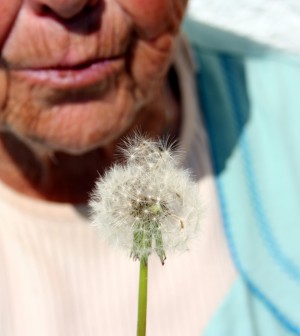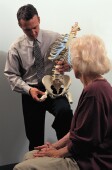- Navigating Your Midlife Crisis: Embracing New Possibilities
- City Raccoons Showing Signs of Domestication
- Mapping the Exposome: Science Broadens Focus to Environmental Disease Triggers
- One Week Less on Social Media Linked to Better Mental Health
- Your Brain Changes in Stages as You Age, Study Finds
- Some Suicide Victims Show No Typical Warning Signs, Study Finds
- ByHeart Formula Faces Lawsuits After Babies Sickened With Botulism
- Switch to Vegan Diet Could Cut Your Greenhouse Gas Emissions in Half
- Regular Bedtime Does Wonders for Blood Pressure
- Dining Alone Could Mean Worse Nutrition for Seniors
Bone-Building Drug Strengthened Hips, Spines of Frail Women in Study


Frail, older women may only need a single dose of the osteoporosis drug Reclast to build bone strength, a new study suggests.
But greater bone density did not translate into fewer fractures among these high-risk women, who were living in nursing homes and assisted-living facilities during the study, the researchers added.
“Two surprising findings emerged,” said study author Dr. Susan Greenspan, a professor of medicine at the University of Pittsburgh.
The drug improved bone strength in the very old and frail as well as it did in younger and more robust seniors, but there was no association between increasing bone density and reducing fractures, she said.
“We first wanted to see if frail elders could even tolerate such treatment, and whether it would improve bone density. However, we had expected to see a positive trend of fewer fractures. But if anything, there were more fractures in the treatment group,” Greenspan said, although “that could well be just a chance finding.”
Greenspan hopes that the U.S. National Institutes of Health, which funded this trial, will fund a larger study to see if treatment with Reclast (zoledronic acid) will actually reduce the risk of fractures.
If a larger trial found that treatment with Reclast did reduce fractures, “it would require rethinking the approach to fracture prevention in this large and growing population, especially since these are the individuals who also are at the highest risk of both fracture and its consequences,” Greenspan explained.
The study was published online April 13 in the journal JAMA Internal Medicine.
Dr. Robert Lindsay, chief of the Osteoporosis Center at Helen Hayes Hospital in West Haverstraw, N.Y., and author of an accompanying journal editorial, said Reclast has been shown to reduce fractures in people with osteoporosis, but several factors may explain why the number of fractures did not decline in this study, even though bone density increased in these older frail women.
Fractures in the elderly occur not only because the bones are weak, but also because people in this group are prone to falls, he said. “Both risks are high in this population. The study tells us that treating one side of the equation, bad bones, can only do so much when the risk of injury is high, because the patients studied were quite frail.”
Weakened bones and osteoporosis are common among the nearly 2 million American women living in these care facilities. These women are at high risk for broken bones and hip fractures that can impair their mobility, limit their independence and hasten death, Greenspan said.
The cost of the drug can be anywhere from $5,800 to $7,000, depending on where it is given (usually administered in a hospital or clinic) and what insurance is covering the drug. According to Medicare, Reclast is covered for recipients. In addition, most insurance plans cover the drug.
For the study, Greenspan and her colleagues assigned 181 women with osteoporosis, aged 65 and older, to a single infusion of Reclast or a placebo. All of the women were also given vitamin D and calcium supplements. Some of these seniors also suffered from mental impairment, immobility and other medical conditions, the researchers noted.
After a year and again after two years, the researchers measured the women’s bone density at their hip and spine. They also tracked any falls or other adverse events.
After a year, women given Reclast saw bone density at the hip increase an average of 2.8 percent, compared with a slight reduction in bone density among women given a placebo. At two years, bone density increased 2.6 percent among women given the drug, but decreased 1.5 percent among those given placebo, the researchers found.
The average bone density at the spine also increased among women treated with Reclast more than women given the placebo. At 12 months bone density increased 3 percent among Reclast users versus 1.1 percent in the placebo group. At 24 months, the increases were 4.5 percent versus 0.7 percent, respectively.
But Greenspan’s group found no significant difference in the number of fractures, heart problems or deaths among women who received the drug or the placebo. Among women treated with Reclast, 20 percent had fractures, as did 16 percent of those treated with placebo. Among those given the drug, 16 percent died, as did 13 percent of those given placebo.
However, more women treated with the drug had multiple falls than did women given the placebo (49 percent versus 35 percent), although this difference was not significant after taking into account frailty at the start of the study, the researchers said. The number of single falls was similar among women in both groups, they added.
More information
Visit the U.S. National Library of Medicine for more on osteoporosis.
Source: HealthDay
Copyright © 2025 HealthDay. All rights reserved.










